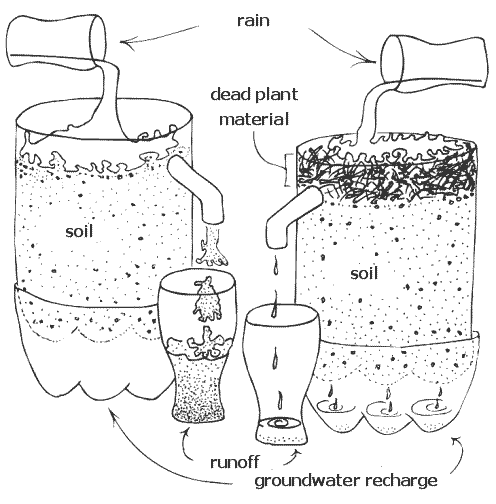In September 1997 I attended Allan Savory's biological course at the Regional Training Centre of the Africa Centre for Holistic Management, at Dibangombe in Zimbabwe. Allan shared the following design from Gero Diekmann of Namibia. This simple and elegant apparatus poses questions that are not widely understood. How does the water cycle function on the land? What causes floods and droughts?

You will need four 2-liter plastic soda bottles or equivalent, four tumblers, the bent hollow handles from two plastic milk jugs or equivalent, a sharp knife, and tar or glue.
Cut the tops off two of the bottles, and make small holes in the bottom to allow water to continue downwards. Use tar or glue to caulk the hollow jug handles (or sections of vinyl tubing) as spouts into holes in the bottles about an inch below the top rim. Fill both containers with soil slightly above the level of the bottom of the spouts, exactly the same on both jugs. It is important to get this right, and some tamping or firming is usually required so water does not immediately wash away the soil surface leading to the spout. Put a layer of dead plant material (litter) on the soil in one of the containers, and this can also be firmed somewhat. Use the bottoms of the remaining bottles under the soil containers. Place tumblers under the runoff spouts, and simulate a rainstorm by pouring 8 ounces (1 cup) of water into each container, preferably through a container with small holes in the bottom to simulate rain.
Note: With soils of limited hydraulic conductivity such as clays, which are very slow to let water infiltrate, this experiment may not show much. It works much better with soils that absorb water readily, because in effect this demonstration accelerates or exaggerates the differences. Because the surface litter slows the runoff, it has more chance to infiltrate into the underlying soil. Where infiltration rates are slow, the litter will not create much of a difference, in part because the rainstorm is so rapid.
But if you are using soils that can accept water readily, just do it where people can see it over the next few minutes. The results require little comment. Second and third rainstorms can also be instructive. Over time, the rates of evaporation from covered and bare soils can be observed.
Calculating the volume of runoff or groundwater recharge per inch of rainfall per unit of surface area is straightforward and shocking. The apparatus can also be used for basic comparisons of water-cycle function using cylindrical cores of topsoil, with existing plants, litter, and humus, taken out of the ground with a posthole digger or bulb planter.
A brief description of the water cycle concept of ecosystem function--how it differs from the hydrologic cycle. This page also includes a short video of this demonstration.